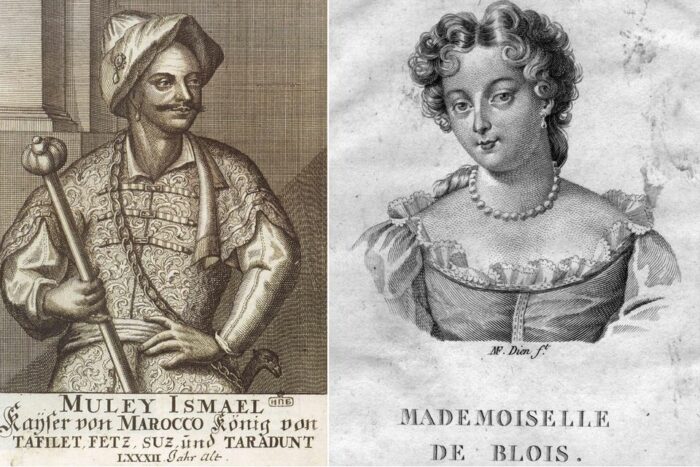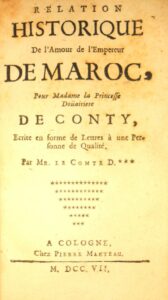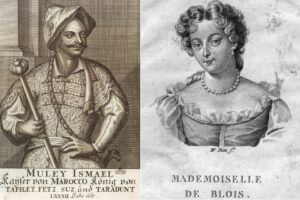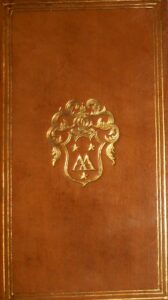[Casimir Freschot]. Relation historique de l’Amour de l’Empereur de Maroc, pour Madame la Princesse Doüairiere de Conty, ecrite en forme de Lettres à une Personne de Qualité, par Mr. le Comte D.***. A Cologne, Chez Pierre Marteau, 1707. Small in-12 of 139 pp. Blond calf, spine with 5 raised bands decorated with gilt fillets, red morocco title-piece, triple gilt fillet framing the boards with a coat of arms in the centre, gilt fillet on the edges, decorated endpapers, gilt edges. (mid-19th century binding).
This rare first edition of this epistolary work tells the true story of the passionate love that the Princesse de Conti, Marie Anne de Bourbon, known as “Mademoiselle de Blois” (1666-1739), “the wonder of Versailles, a prodigy of beauty”, the fruit of Louis XIV’s love affair with Madame de La Vallière, aroused in the heart of the powerful Moroccan king Moulay Ismaïl (1645-1727), “the most bloodthirsty despot of his time”, on seeing her portrait.
The Sultan, who was also keen to strengthen diplomatic and economic relations with France, toyed with the idea of marriage and entered into negotiations, to which the Count of Pontchartrain, Secretary of State for the Navy, did not feel he had to respond, arguing that he did not dare show letters that were so out of keeping with the morals of the two nations. To console Moulay Ismaïl, Louis XIV sent him, in place of his daughter, four Comtois clocks, which pleased the Cherifian sovereign so much that he had them placed around his mausoleum. “These letters are founded on the historical fact that Moulai Ismail had the effrontery to ask in marriage Mdlle. de Blois, […] an incident which sent half the writers of Versailles into verse and epigram” (Playfair).
Another edition appeared the same year, printed in large print characters on 256 pp.
This account suggests that the eleven letters signed N.N. are by Freschot, since he signed another work with these same initials and the style used is similar..
Copy bearing the heraldic cipher of Adolphe Audenet (1800-1872), banker, judge at the Tribunal de Commerce de la Seine, director of L’Urbaine, a limited insurance company, and of the Compagnie [financière] des quatre canaux.
A subscriber to the Bibliothèque de l’École des Chartes, he was also a member of the Société de l’Histoire de France. Guided by Techener père, Audenet built up one of the most interesting libraries of his time, which was sold in 21 auctions in 1841. The most valuable volumes in his library bore two intertwined A’s on the sides, accompanied by three stars, two in chief and one in base; the shield was surmounted by a grilled helmet, set on a fess and surrounded by mantling. Audenet soon put together a new library. It did not have the same importance as the first one, but it was commended for its choice of works of history and literature, and above all for the way they were dressed, the books that he himself had had bound being stamped with his heraldic cipher. It was dispersed from 9 to 14 February 1874, after his death.
Few rare rubbing to the binding.
Brunet, Manuel du libraire, t. IV, col. 1207 and 17297 [Romans historico-satiriques, relatifs aux amours de plusieurs grands personnages des temps modernes, ed. datée 1700] ; J. Gay, Bibliographie des ouvrages relatifs à l’amour, t. VI, p. 203 ; Playfair, A Bibliography of Morocco, n° 318.
A rare first edition with a prestigious provenance.
2 800 €



